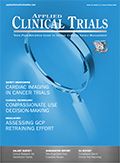Emerging Biopharma Find Ways to Persevere Struggles
Applied Clinical Trials
David Arthur, CEO of Salarius, discusses efficacy, collaborating with nonprofit institutes to obtain funding, and garnering patient support to increase recruitment in clinical trials.

The emerging biopharmaceutical space finds innovative ways to survive the challenges that exist when developing therapies for very rare designations. Enterprises, such as Salarius Pharmaceuticals, are incorporating endpoints into early-stage clinical trials that could offer a glimpse into efficacy and are collaborating with nonprofit institutes to obtain funding and garner patient support to bolster recruitment efforts for clinical trials. In this interview, David Arthur, CEO of Salarius, discusses these topics.
Moe Alsumidaie: Describe the unique challenges Salarius encountered with its Ewing sarcoma clinical trial program and, how did you overcome those issues?
David Arthur: The biggest challenge is selecting clinical trial sites and managing patient demand. There are roughly 500 new cases of Ewing sarcoma diagnosed each year. Because there are approved therapies for Ewing sarcoma, albeit not targeted therapies, our Phase I/II study enrolls patients who have relapsed or failed to respond to those standard therapies. This is a subset of an already small patient population. So, when selecting clinical trial sites, you need to take a thoughtful, strategic approach and identify the medical facilities and hospitals that attract Ewing sarcoma patients. It is also essential to manage demand. These patients are children and young adults who have relapsed or failed to respond and face a five-year mortality rate of 70% to 80%, and they are desperate for new therapeutic options. Our study has a small number of spots available to patients, so we must adequately evaluate everyone to ensure that the right patients are enrolled in the study and that everyone is treated fairly.
MA: Describe the study’s design and endpoints. Will it collect efficacy data?
Arthur: Our Phase I/II clinical trial is a dose-escalation (phase I)/dose-expansion (phase II) study designed to assess safety but could also provide a glimpse at efficacy signals. The dose-expansion phase begins by treating patients with Seclidemstat at a low dose, approved by the FDA, for a month. Once our safety review committee approves us to advance, we enroll additional patients and increase the dosage. The dosage levels, referred to as cohorts, increase until we reach what is known as dose-limiting toxicity. At that point, we drop the drug dosage down to what we establish as the maximum-tolerated dose. The trial then moves into the dose-expansion phase, where we expect to enroll at least 14 additional patients and administer the maximum-tolerated dose for up to two years.
In our ongoing Phase I/II trial, safety is the primary endpoint, but there are some secondary endpoints, including overall response rate and progression-free survival. Because our patients have a rapidly progressing cancer with a high mortality rate, showing small improvements in these efficacy parameters would be meaningful and should excite treating physicians about Seclidemstat’s potential as a Ewing sarcoma treatment.
MA: Which is the more significant challenge-recruiting patients or recruiting qualified clinical trial sites?
Arthur: It’s challenging to separate site selection and patient recruitment because the two go hand in hand. When selecting clinical trial sites, it’s vital to identify the premiere organizations and research facilities around the country where patients with a particular medical condition seek care. Patients choose these facilities because there are physicians with experience and expertise in treating their condition and there is research underway to develop cutting-edge therapies.
MA: Describe your patient recruitment strategy. Has Salarius implemented a recruitment campaign?
Arthur: Fortunately, Salarius receives support from the National Pediatric Cancer Foundation (NPCF). The NPCF’s mission is to fund research to fast-track less toxic, more targeted treatments for childhood cancers by partnering with leading hospitals nationwide. The NPCF is excited about Seclidemstat, and we have not only received financial support from the organization, but we have been given access to the Sunshine Project hospital system. This is a network of roughly 25 premiere research hospitals around the country created with the purpose of expediting clinical trials of new, breakthrough cancer therapies.
The advocacy in Ewing sarcoma, as well as the connectivity among parents and parent groups, is impressive. The parents of these patients will stop at nothing to find new therapies. There are advocacy groups, such as the NPCF, and a network of former patients who maintain email lists and distribute information about clinical trials. Once they knew Salarius was initiating a Ewing sarcoma study, word spread like wildfire. After that, it was a matter of making sure that Salarius partnered with the right hospitals and research facilities.
Right now, we have eight active sites: Dana-Farber Cancer Institute in Boston; Memorial Sloan Kettering in New York; Moffitt Cancer Center in Tampa, FL.; John Hopkins All Children’s Hospital in St. Petersburg, FL.; University of Texas MD Anderson Cancer Center in Houston; Nationwide Children’s Hospital in Columbus, OH; Children’s Hospital Los Angeles; and the Sarcoma Oncology Center in Santa Monica, CA.
MA: Let’s discuss inter-rater variability. Is each trial site responsible for its own measurements, or does the study engage a central radiologist?
Arthur: The ongoing Phase I/II trial is focused on safety data with efficacy as a secondary endpoint. We believe it is best to rely on individual hospitals to handle the scans and utilize their radiology expertise. After all, we’re talking about some of the premiere medical institutions in the country. When we move into a registration study with efficacy as a primary endpoint, we will make sure to reduce or eliminate variability.
MA: What challenges do you see ahead as Salarius advances Seclidemstat into more extensive and later-stage clinical trials?
Arthur: Bigger clinical trials are expensive undertakings. Some companies double or triple the number of trial sites or look overseas to find patients. Add to that a rare disease indication with a small patient population, and the complexity rises several levels. Just finding clinical trial sites where you aren’t competing with rival studies recruiting the same patients can prove challenging.
Thankfully, the FDA has several programs in place to help accelerate the development of life-saving therapies for orphan indications, especially in pediatric populations. No matter how high the unmet need, some rare disease indications simply don’t attract big dollars from the investment community. This is why it is so important to recognize organizations like the Cancer Prevention Research Institute of Texas and the National Pediatric Cancer Foundation for the work they do filling the gaps.
Moe Alsumidaie, MBA, MSF, is a thought leader and expert in the application of business analytics toward clinical trials, and Editorial Advisory Board member for and regular contributor to Applied Clinical Trials.

Improving Relationships and Diversifying the Site Selection Process
April 17th 2025In this episode of the Applied Clinical Trials Podcast, Liz Beatty, co-founder and chief strategy officer, Inato, discusses a number of topics around site engagement including community-based sites, the role of technology in improving site/sponsor relationships, how increased operational costs are impacting the industry, and more.
Behind the Buzz: Why Clinical Research Leaders Flock to SCOPE Summit
February 7th 2025In this episode, we meet with Micah Lieberman, Executive Conference Director for SCOPE Summit (Summit for Clinical Ops Executives) at Cambridge Innovation Institute. We will dive deep into the critical role of collaboration within the clinical research ecosystem. How do we bring together diverse stakeholders—sponsors, CROs, clinical trial tech innovators, suppliers, patients, sites, advocacy organizations, investors, and non-profits—to share best practices in trial design, program planning, innovation, and clinical operations? We’ll explore why it’s vital for thought leaders to step beyond their own organizations and learn from others, exchanging ideas that drive advancements in clinical research. Additionally, we’ll discuss the pivotal role of scientific conferences like SCOPE Summit in fostering these essential connections and collaborations, helping shape the future of clinical trials. Join us as we uncover how collective wisdom and cross-industry partnerships are transforming the landscape of clinical research.